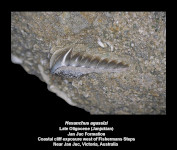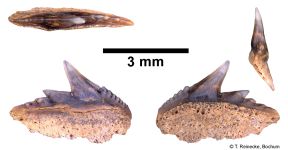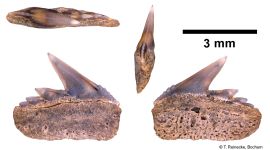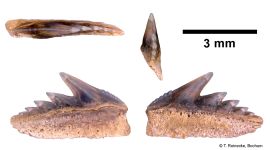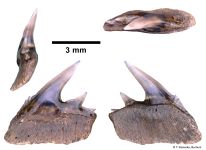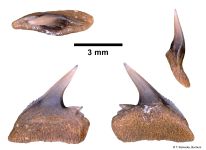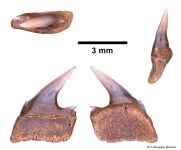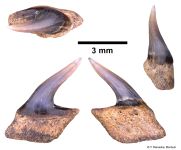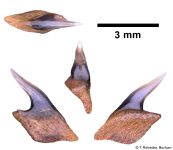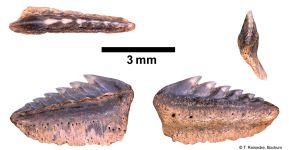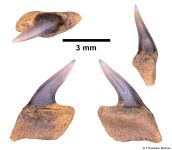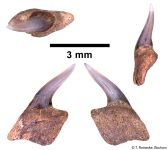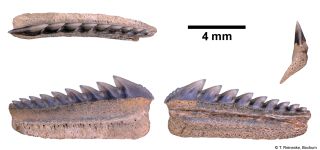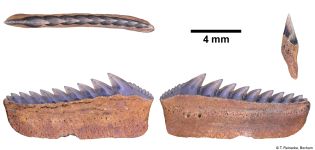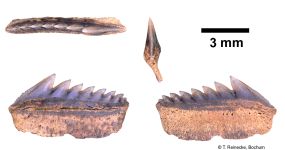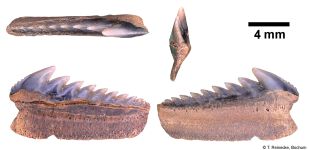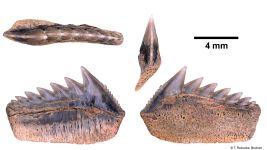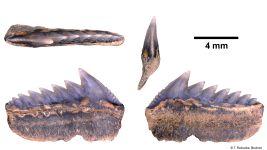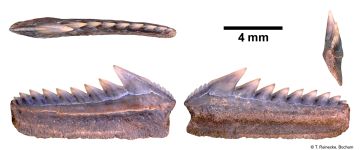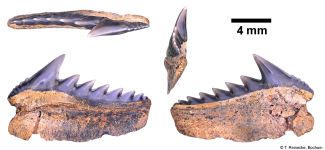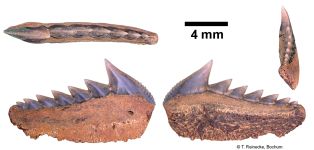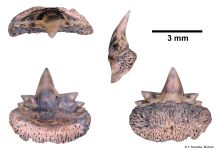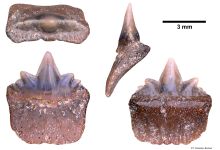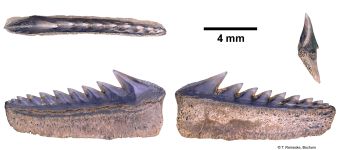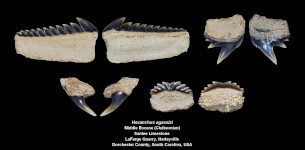Hexanchus agassizi
Cappetta, 1976
Classification: Elasmobranchii Hexanchiformes Hexanchidae
Reference of the original description
Sélaciens nouveaux du London Clay de l'Essex (Yprésien du Bassin de Londres). Geobios, 9(5), 551–575
Sélaciens nouveaux du London Clay de l'Essex (Yprésien du Bassin de Londres). Geobios, 9(5), 551–575
Synonyms / new combinations and misspellings
Hexanchus cf. agassizi, Hexanchus collinsonae, Hexanchus hookeri
Hexanchus cf. agassizi, Hexanchus collinsonae, Hexanchus hookeri
Types
Hexanchus agassizi
Holotype: USTL: BOC 5;
Hexanchus collinsonae
Holotype: BMNH(fossil): P.60134; Paratype: BMNH(fossil): P.60135; BMNH(fossil): P.60136;
Hexanchus hookeri
Holotype: BMNH(fossil): P.60131; Paratype: BMNH(fossil): P.60132; BMNH(fossil): P.60133;
Hexanchus agassizi
Holotype: USTL: BOC 5;
Hexanchus collinsonae
Holotype: BMNH(fossil): P.60134; Paratype: BMNH(fossil): P.60135; BMNH(fossil): P.60136;
Hexanchus hookeri
Holotype: BMNH(fossil): P.60131; Paratype: BMNH(fossil): P.60132; BMNH(fossil): P.60133;
Description:
Citation: Hexanchus agassizi Cappetta, 1976: In: Database of fossil elasmobranch teeth www.shark-references.com, World Wide Web electronic publication, Version 01/2026
Please send your images of "Hexanchus agassizi" to info@shark-references.com
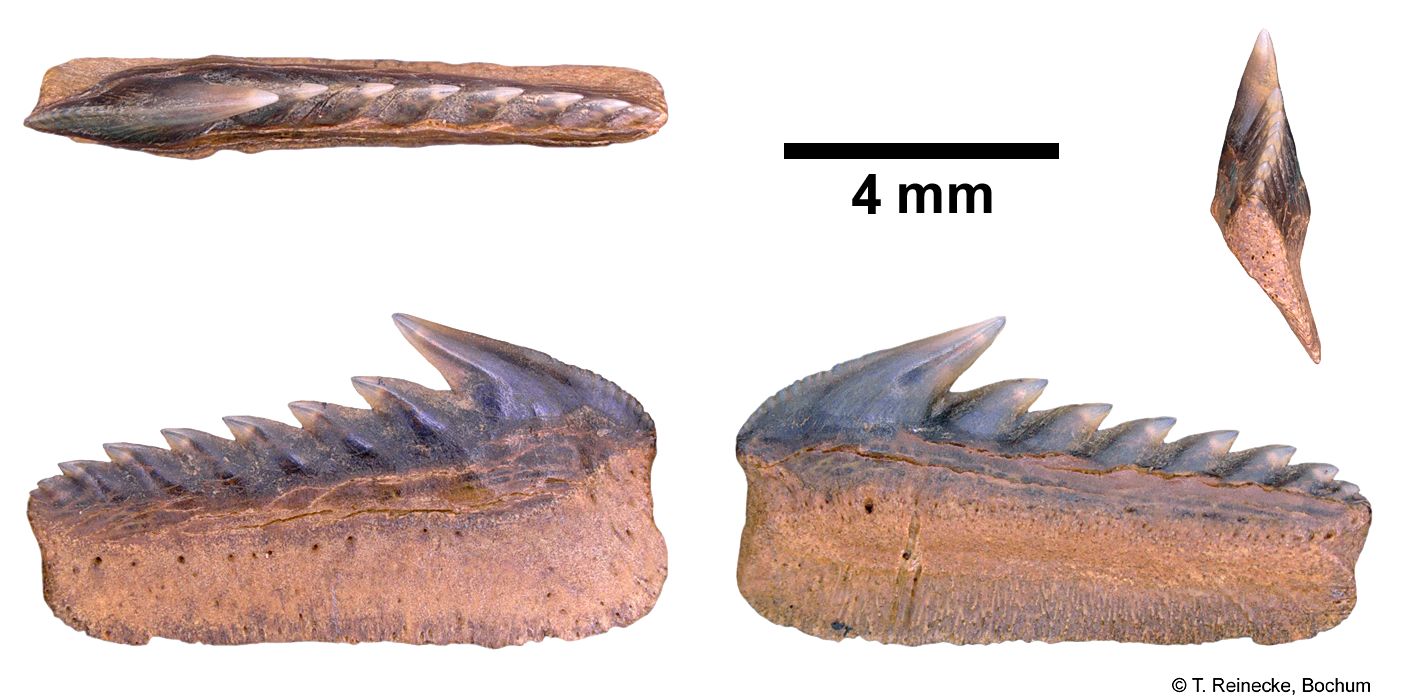
Hexanchus agassizi Cappetta, 1976, London Clay Formation, Division D, Sheppey Member, Ypresian, early Eocene; Cliff Reach, Burnham-on-Crouch, UK © T. Reinecke, Bochum

Hexanchus agassizi Cappetta, 1976, London Clay Formation, Division D, Sheppey Member, Ypresian, early Eocene; Cliff Reach, Burnham-on-Crouch, UK © T. Reinecke, Bochum
Description
Original diagnosis after Cappetta (1976) p. 554 [323]: Dents de petite taille (n'excédant pas 13 mm de longueur), environ deux lois plus longues que hautes ; dents latérales comportant de 7 à 10 cônes ; acrocône gé peine plus développé que le premier cône secondaire ; tranchant mésial de l'acrocône presque droit et portant g sa base quelques dentelures ; dents arquées en vue occlusale. Racine peu épaisse à face basilaire déprimée.
Original diagnosis after Cappetta (1976) p. 554 [323]: Dents de petite taille (n'excédant pas 13 mm de longueur), environ deux lois plus longues que hautes ; dents latérales comportant de 7 à 10 cônes ; acrocône gé peine plus développé que le premier cône secondaire ; tranchant mésial de l'acrocône presque droit et portant g sa base quelques dentelures ; dents arquées en vue occlusale. Racine peu épaisse à face basilaire déprimée.
Remarks
shark-references Species-ID=2841;
valid after Ward (1979) p. 114 [2493]; Adnet & Martin (2007) p. 280 [22]; Migom et al. (2021) p. 11 [29914]; Zalat et al. (2017) p. 204 [25860];
shark-references Species-ID=2841;
valid after Ward (1979) p. 114 [2493]; Adnet & Martin (2007) p. 280 [22]; Migom et al. (2021) p. 11 [29914]; Zalat et al. (2017) p. 204 [25860];
References
Paleozoic, Mesozoic and Cenozoic Chondrichthyes from the Japanese Islands. National Museum of Nature and Science Monographs, 56, 1–184

Fossil chondrichthyans of the Carpathian-Pannonian Region (in Hungarian: A Kárpát-Pannon-térség fosszilis porcoshalai). Hungarian Natural History Museum, Dabasi Nyomda Zrt., Budapest. 255 pages, ISBN 978-963-9877-52-8
Middle Eocene chondrichthyan fauna from Antarctic Peninsula housed in the Museo de La Plata, Argentina. Advances in Polar Science, 35(1), 14–47
DOI: 10.12429/j.advps.2023.0035
Middle Eocene cartilaginous fishes (Vertebrata: Chondrichthyes) of the Dnieper–Donets Basin, northern Ukraine. Palaeontologia Electronica, 26(2), Article a32

Fossile hajtaender fra Trelde Naes. Self-published

The Lower Eocene (Ypresian) Chondrichthyes from Egem, Belgium. Part 1, Orders: Hexanchiformes, Squaliformes, Squatiniformes, Heterodontiformes and Orectolobiformes. Palaeo Ichthyologica, 15, 1–55
Fossil Chondrichthyes from the Neogene of Portugal: Diversity and Occurrence. Anuário do Instituto de Geociências, 44, Article 43395
DOI: 10.11137/1982-3908_2021_44_43395
Haie im Alpenvorland - Fossile Zeugen eines verschwundenen Paradieses. Verlag Anton Pustet, Salzburg, ISBN-10: 3702510230

A mesopelagic selachian fauna from the middle Eocene of St. Pankraz (Austria) reveals homogeneity in deep-marine environments during the warm period in Europe. Neues Jahrbuch für Geologie und Paläontologie, Abhandlungen, 301(1), 25–63
DOI: 10.1127/njgpa/2021/0996

Shark fossil diversity (Squalomorphii, Squatinomorphii, and Galeomorphii) from the Langhian of Brielas (Lower Tagus Basin, Portugal). Geological Journal, 56, 405–421
DOI: 10.1002/gj.3965
Cretaceous and Paleogene Fossils of North Carolina, A Field Guide. North Carolina Fossil Club, Durham, 70 p. 2019 Edition

Nachweise der Selachier-Gattung Hexanchus RAFINESQUE, 1810, aus paläogenen Geschieben Norddeutschlands. Arbeitskreis Paläontologie Hannover, 47, 97–116

New data on the elasmobranch fauna of the Eferding Formation (Egerian, North Alpine Foreland Basin) of Austria [Abstract]. Book of Abstracts, 25. Jahrestagung ÖPG, Bad Vöslau, 11.-13.10.2019

A new outer neritic elasmobranch assemblage from the Egerian (late Oligocene) of the North Alpine Foreland Basin (Austria). Neues Jahrbuch für Geologie und Paläontologie, Abhandlungen, 293(1), 19–35
DOI: 10.1127/njgpa/2019/0828

First record of the hexanchoid shark genus Crassodontidanus (Chondrichthyes: Hexanchiformes) from the Jurassic of Hungary (Mecsek Mts, Southern Hungary), with a summary of the hexanchiform fossil record of Hungary. Fragmenta Palaeontologica Hungarica, 35, 87–102

Knorpelfische (Chondrichthyes) In Kürsteiner, P., & Klug, C. (eds). Fossilien im Alpstein: Kreide und Eozän der Nordostschweiz. Appenzeller Medienhaus. pp. 325–343
Taxonomy and morphological study on the vertebrate remains of Shark and rays fauna from the Middle and Late Eocene succession, Fayoum Depression, Egypt. Delta Journal of Science, 38, 202–217

A preliminary report on the early Oligocene (Rupelian, Kiscellian) selachians from the Kiscell Formation (Buda Mts, Hungary), with the re-discovery of Wilhelm Weiler’s shark teeth. Fragmenta Palaeontologica Hungarica, 33, 31–64
DOI: 10.17111/FragmPalHung.2016.33.1

Tiburones, Rayas y Quimeras (Chondrichthyes) Fósiles de Chile. Publicación Ocasional del Museo Nacional de Historia Natural, Chile, 63: 17–33

Chondrichthyans from a lag deposit between the Shark River Formation (Middle Eocene) and Kirkwood Formation (Early Miocene), Monmouth county, New Jersey. Paludicola, 10(3), 149–183

The elasmobranch fauna of the Thalberg Beds, early Egerian (Chattian, Oligocene), in the Subalpine Molasse Basin near Siegsdorf, Bavaria, Germany. Palaeontos, 26, 1–127
A study of the sharks and rays from the Lillebælt Clay (Early–Middle Eocene) of Denmark, and their palaeoecology. Bulletin of the Geological Society of Denmark, 62, 39–88
DOI: 10.37570/bgsd-2014-62-04

Pisces. In Piller, W.E. (ed.) Catalogus Fossilium Austriae, Band 3 - Verlag der Österreichischen Akademie der Wissenschaften, Wien, ISBN13: 978-3-7001-7238-3, 576 pp.

Neoselachians and Chimaeriformes (Chondrichthyes) from the latest Cretaceous-Paleogene of Sierra Baguales, southernmost Chile. Chronostratigraphic, paleobiogeographic and paleoenvironmental implications. Journal of South American Earth Sciences, 48, 13–30
DOI: 10.1016/j.jsames.2013.07.013

The Aktulagay section, west Kazakhstan: a key site fornorthern mid-latitude Early Eocene stratigraphy. Stratigraphy, 10(3): 171–209
Priabonian sharks and rays (late Eocene: Neoselachii) from Minqar Tabaghbagh in the Western Qattara Depression, Egypt. Contributions from the Museum of Paleontology, University of Michigan, 32(6): 71–90

Shark and ray faunas in the Middle and Late Eocene of the Fayum Area, Egypt. Proceedings of the Geologists' Association, 122(1), 47–66
DOI: 10.1016/j.pgeola.2010.09.004

Paleo-environments of the exposed Eocene Sediments between Wadi El-Hitan and east Siwa in the Egyptian Western Desert based on their faunal content especially the vertebrates. Thesis, Zagazig University, Faculty of Science, Geology Department

London Clay Fossils of Kent and Essex. Rochester, Kent, Medway Fossil and Mineral Society, 228 p, ISBN: 978–0–9538243–1–1

London Clay Fossils of Kent and Essex. Rochester, Kent, Medway Fossil and Mineral Society, 228 p, ISBN: 978–0–9538243–1–1

Cretaceous and Paleogene Fossils of North Carolina, A Field Guide. North Carolina Fossil Club, Durham, 70 p.

Identificación de Especies Fósiles de la Zona de Sierra Baguales, Provincia de Última Esperanza, Región de Magallanes, Patagonia. Graduate Thesis(Unpublished), Universidad de Magallanes: 67 p.
Contribution of Eocene sharks and rays from southern France to the history of deep-sea selachians. Acta Geologica Polonica, 58(2), 257–260

Increase of body size in sixgill sharks with change in diet as a possible background of their evolution. Historical Biology, 19(4), 279–289
DOI: 10.1080/08912960701194461

Increase of body size in sixgill sharks with change in diet as a possible background of their evolution. Historical Biology, 19(4), 279–289
DOI: 10.1080/08912960701194461

Increase of body size in sixgill sharks with change in diet as a possible background of their evolution. Historical Biology, 19(4), 279–289
DOI: 10.1080/08912960701194461

Fossil shark teeth from the Namigata Formation in Ibara City, Okayama Prefecture, Central Japan and their biostratigraphical significance. Bulletin of the Mizunami Fossil Museum, 33, 103–109

(Elasmobranchs of the western margin of the West Siberian Paleogene basin.) «in russian». Ekaterinburg: IGG UB RAS, 2006, 224 p., ICC 5–94332–048–2

Nouvelles faunes de sélaciens (Elasmobranchii, Neoselachii) de l'Éocène des Landes (Sud-Ouest, France). Implication dans les connaissances des communautés d'eaux profondes. Palaeo Ichthyologica, 10, 1–128
Biometric analysis of the teeth of fossil and Recent hexanchid sharks and its taxonomic implications. Acta Palaeontologica Polonica, 51(3), 477–488
Biometric analysis of the teeth of fossil and Recent hexanchid sharks and its taxonomic implications. Acta Palaeontologica Polonica, 51(3), 477–488
Biometric analysis of the teeth of fossil and Recent hexanchid sharks and its taxonomic implications. Acta Palaeontologica Polonica, 51(3), 477–488

Review of the Middle Eocene (Lutetian) selachian fauna of Jebal eth Thuleithuwat, east Jordan. Neues Jahrbuch für Geologie und Paläontologie, Abhandlungen, 237(3), 399–422

London Clay Fossils of the Isle of Sheppey. Medway Lapidary and Mineral Society, ISBN 0-9538243-0-6, 100pp.

London Clay Fossils of the Isle of Sheppey. Medway Lapidary and Mineral Society, ISBN 0-9538243-0-6, 100pp.

Les élasmobranches fossiles du Paléogène des Landes (Sud-Ouest, France). Implications dans la connaissance des communautés d'élasmobranches d'eaux profondes. Evolution des Squaliformes et paléoécologie. 211 p., 23 fig., annexes, 40 pl. Dipl. Doct., Univ. Montpellier II.

Late Mesozoic and Cenozoic fish faunas of Japan. Island Arc, 3(4), 255–269
DOI: 10.1111/j.1440-1738.1994.tb00115.x

Fossil Sharks of the Chesapeake Bay Region. Egan Rees and Boyer, Inc. Columbia. 146 pp.


Chapter 15: Chondrichthyans in the Cretaceous and Tertiary of Australia. Vertebrate Palaeontology of Australasia: 497–568, 40 pl.

A checklist of Neoselachii (Pisces, Chondrichthyes) from the Palaeogene of the Paris Basin, France. Tertiary Research, 13(1) , 27–36

Stand der Untersuchungen an der Chondrichthyes-Fauna des nordwestdeutschen Tertiärs. Beiträge zur regionalen Geologie der Erde, 18, 503–509

Fossilfunde aus den Deckschichten des Helmstedter Braunkohlereviers. Aufschluss, 37(10), 343–349
Elasmobranch teeth (Vertebrata, Pisces) from the Dongen Formation (Eocene) in the Netherlands. Mededelingen Van De Werkgroep Voor Tertiaire En Kwartaire Geologie, 22(2), 73–122

Die marinen Deckschichten (Mitteleozän-Unteroligozän) der Helmstedter Braunkohlen (Niedersachsen, BRD). Documenta naturae, 22, 1–120

Chondrichthyans in the Tertiary of Australia. In : Rich, P.V., Thompson, E.M. (Eds), The fossil vertebrate record of Australasia. Clayton, Victoria, Australia, Monash University Offset Printing Unit: 88–118

Fossil sharks, rays and chimaeroids of the English Tertiary period. Gosport Museum, 1–47, 10 fig., 3 tabl., 16 pl.

Fossil sharks, rays and chimaeroids of the English Tertiary period. Gosport Museum, 1–47, 10 fig., 3 tabl., 16 pl.

Fossil sharks, rays and chimaeroids of the English Tertiary period. Gosport Museum, 1–47, 10 fig., 3 tabl., 16 pl.

The distribution of sharks, rays and chimaeroids in the English Palaeogene. Tertiary Research, 3(1), 13–19

The distribution of sharks, rays and chimaeroids in the English Palaeogene. Tertiary Research, 3(1), 13–19

The distribution of sharks, rays and chimaeroids in the English Palaeogene. Tertiary Research, 3(1), 13–19

Additions to the fish fauna of the English Palaeogene. 3. A review of the Hexanchid sharks with a description of four new species. Tertiary Research, 2(3), 111–129

Additions to the fish fauna of the English Palaeogene. 3. A review of the Hexanchid sharks with a description of four new species. Tertiary Research, 2(3), 111–129
Detailed comparisons of the dentitions of extant hexanchid sharks and Tertiary hexanchid teeth from South Australia and Victoria, Australia (Selachii: Hexanchidae). Memoirs of the Museum Victoria, 39, 61–83

Sélaciens nouveaux du London Clay de l'Essex (Yprésien du Bassin de Londres). Geobios, 9(5), 551–575
DOI: 10.1016/S0016-6995(76)80024-1
Paleozoic, Mesozoic and Cenozoic Chondrichthyes from the Japanese Islands. National Museum of Nature and Science Monographs, 56, 1–184

Fossil chondrichthyans of the Carpathian-Pannonian Region (in Hungarian: A Kárpát-Pannon-térség fosszilis porcoshalai). Hungarian Natural History Museum, Dabasi Nyomda Zrt., Budapest. 255 pages, ISBN 978-963-9877-52-8
Middle Eocene chondrichthyan fauna from Antarctic Peninsula housed in the Museo de La Plata, Argentina. Advances in Polar Science, 35(1), 14–47
DOI: 10.12429/j.advps.2023.0035
Middle Eocene cartilaginous fishes (Vertebrata: Chondrichthyes) of the Dnieper–Donets Basin, northern Ukraine. Palaeontologia Electronica, 26(2), Article a32

Fossile hajtaender fra Trelde Naes. Self-published

The Lower Eocene (Ypresian) Chondrichthyes from Egem, Belgium. Part 1, Orders: Hexanchiformes, Squaliformes, Squatiniformes, Heterodontiformes and Orectolobiformes. Palaeo Ichthyologica, 15, 1–55
Fossil Chondrichthyes from the Neogene of Portugal: Diversity and Occurrence. Anuário do Instituto de Geociências, 44, Article 43395
DOI: 10.11137/1982-3908_2021_44_43395
Haie im Alpenvorland - Fossile Zeugen eines verschwundenen Paradieses. Verlag Anton Pustet, Salzburg, ISBN-10: 3702510230

A mesopelagic selachian fauna from the middle Eocene of St. Pankraz (Austria) reveals homogeneity in deep-marine environments during the warm period in Europe. Neues Jahrbuch für Geologie und Paläontologie, Abhandlungen, 301(1), 25–63
DOI: 10.1127/njgpa/2021/0996

Shark fossil diversity (Squalomorphii, Squatinomorphii, and Galeomorphii) from the Langhian of Brielas (Lower Tagus Basin, Portugal). Geological Journal, 56, 405–421
DOI: 10.1002/gj.3965
Cretaceous and Paleogene Fossils of North Carolina, A Field Guide. North Carolina Fossil Club, Durham, 70 p. 2019 Edition

Nachweise der Selachier-Gattung Hexanchus RAFINESQUE, 1810, aus paläogenen Geschieben Norddeutschlands. Arbeitskreis Paläontologie Hannover, 47, 97–116

New data on the elasmobranch fauna of the Eferding Formation (Egerian, North Alpine Foreland Basin) of Austria [Abstract]. Book of Abstracts, 25. Jahrestagung ÖPG, Bad Vöslau, 11.-13.10.2019

A new outer neritic elasmobranch assemblage from the Egerian (late Oligocene) of the North Alpine Foreland Basin (Austria). Neues Jahrbuch für Geologie und Paläontologie, Abhandlungen, 293(1), 19–35
DOI: 10.1127/njgpa/2019/0828

First record of the hexanchoid shark genus Crassodontidanus (Chondrichthyes: Hexanchiformes) from the Jurassic of Hungary (Mecsek Mts, Southern Hungary), with a summary of the hexanchiform fossil record of Hungary. Fragmenta Palaeontologica Hungarica, 35, 87–102

Knorpelfische (Chondrichthyes) In Kürsteiner, P., & Klug, C. (eds). Fossilien im Alpstein: Kreide und Eozän der Nordostschweiz. Appenzeller Medienhaus. pp. 325–343
Taxonomy and morphological study on the vertebrate remains of Shark and rays fauna from the Middle and Late Eocene succession, Fayoum Depression, Egypt. Delta Journal of Science, 38, 202–217

A preliminary report on the early Oligocene (Rupelian, Kiscellian) selachians from the Kiscell Formation (Buda Mts, Hungary), with the re-discovery of Wilhelm Weiler’s shark teeth. Fragmenta Palaeontologica Hungarica, 33, 31–64
DOI: 10.17111/FragmPalHung.2016.33.1

Tiburones, Rayas y Quimeras (Chondrichthyes) Fósiles de Chile. Publicación Ocasional del Museo Nacional de Historia Natural, Chile, 63: 17–33

Chondrichthyans from a lag deposit between the Shark River Formation (Middle Eocene) and Kirkwood Formation (Early Miocene), Monmouth county, New Jersey. Paludicola, 10(3), 149–183

The elasmobranch fauna of the Thalberg Beds, early Egerian (Chattian, Oligocene), in the Subalpine Molasse Basin near Siegsdorf, Bavaria, Germany. Palaeontos, 26, 1–127
A study of the sharks and rays from the Lillebælt Clay (Early–Middle Eocene) of Denmark, and their palaeoecology. Bulletin of the Geological Society of Denmark, 62, 39–88
DOI: 10.37570/bgsd-2014-62-04

Pisces. In Piller, W.E. (ed.) Catalogus Fossilium Austriae, Band 3 - Verlag der Österreichischen Akademie der Wissenschaften, Wien, ISBN13: 978-3-7001-7238-3, 576 pp.

Neoselachians and Chimaeriformes (Chondrichthyes) from the latest Cretaceous-Paleogene of Sierra Baguales, southernmost Chile. Chronostratigraphic, paleobiogeographic and paleoenvironmental implications. Journal of South American Earth Sciences, 48, 13–30
DOI: 10.1016/j.jsames.2013.07.013

The Aktulagay section, west Kazakhstan: a key site fornorthern mid-latitude Early Eocene stratigraphy. Stratigraphy, 10(3): 171–209
Priabonian sharks and rays (late Eocene: Neoselachii) from Minqar Tabaghbagh in the Western Qattara Depression, Egypt. Contributions from the Museum of Paleontology, University of Michigan, 32(6): 71–90

Shark and ray faunas in the Middle and Late Eocene of the Fayum Area, Egypt. Proceedings of the Geologists' Association, 122(1), 47–66
DOI: 10.1016/j.pgeola.2010.09.004

Paleo-environments of the exposed Eocene Sediments between Wadi El-Hitan and east Siwa in the Egyptian Western Desert based on their faunal content especially the vertebrates. Thesis, Zagazig University, Faculty of Science, Geology Department

London Clay Fossils of Kent and Essex. Rochester, Kent, Medway Fossil and Mineral Society, 228 p, ISBN: 978–0–9538243–1–1

London Clay Fossils of Kent and Essex. Rochester, Kent, Medway Fossil and Mineral Society, 228 p, ISBN: 978–0–9538243–1–1

Cretaceous and Paleogene Fossils of North Carolina, A Field Guide. North Carolina Fossil Club, Durham, 70 p.

Identificación de Especies Fósiles de la Zona de Sierra Baguales, Provincia de Última Esperanza, Región de Magallanes, Patagonia. Graduate Thesis(Unpublished), Universidad de Magallanes: 67 p.
Contribution of Eocene sharks and rays from southern France to the history of deep-sea selachians. Acta Geologica Polonica, 58(2), 257–260

Increase of body size in sixgill sharks with change in diet as a possible background of their evolution. Historical Biology, 19(4), 279–289
DOI: 10.1080/08912960701194461

Increase of body size in sixgill sharks with change in diet as a possible background of their evolution. Historical Biology, 19(4), 279–289
DOI: 10.1080/08912960701194461

Increase of body size in sixgill sharks with change in diet as a possible background of their evolution. Historical Biology, 19(4), 279–289
DOI: 10.1080/08912960701194461

Fossil shark teeth from the Namigata Formation in Ibara City, Okayama Prefecture, Central Japan and their biostratigraphical significance. Bulletin of the Mizunami Fossil Museum, 33, 103–109

(Elasmobranchs of the western margin of the West Siberian Paleogene basin.) «in russian». Ekaterinburg: IGG UB RAS, 2006, 224 p., ICC 5–94332–048–2

Nouvelles faunes de sélaciens (Elasmobranchii, Neoselachii) de l'Éocène des Landes (Sud-Ouest, France). Implication dans les connaissances des communautés d'eaux profondes. Palaeo Ichthyologica, 10, 1–128
Biometric analysis of the teeth of fossil and Recent hexanchid sharks and its taxonomic implications. Acta Palaeontologica Polonica, 51(3), 477–488
Biometric analysis of the teeth of fossil and Recent hexanchid sharks and its taxonomic implications. Acta Palaeontologica Polonica, 51(3), 477–488
Biometric analysis of the teeth of fossil and Recent hexanchid sharks and its taxonomic implications. Acta Palaeontologica Polonica, 51(3), 477–488

Review of the Middle Eocene (Lutetian) selachian fauna of Jebal eth Thuleithuwat, east Jordan. Neues Jahrbuch für Geologie und Paläontologie, Abhandlungen, 237(3), 399–422

London Clay Fossils of the Isle of Sheppey. Medway Lapidary and Mineral Society, ISBN 0-9538243-0-6, 100pp.

London Clay Fossils of the Isle of Sheppey. Medway Lapidary and Mineral Society, ISBN 0-9538243-0-6, 100pp.

Les élasmobranches fossiles du Paléogène des Landes (Sud-Ouest, France). Implications dans la connaissance des communautés d'élasmobranches d'eaux profondes. Evolution des Squaliformes et paléoécologie. 211 p., 23 fig., annexes, 40 pl. Dipl. Doct., Univ. Montpellier II.

Late Mesozoic and Cenozoic fish faunas of Japan. Island Arc, 3(4), 255–269
DOI: 10.1111/j.1440-1738.1994.tb00115.x

Fossil Sharks of the Chesapeake Bay Region. Egan Rees and Boyer, Inc. Columbia. 146 pp.


Chapter 15: Chondrichthyans in the Cretaceous and Tertiary of Australia. Vertebrate Palaeontology of Australasia: 497–568, 40 pl.

A checklist of Neoselachii (Pisces, Chondrichthyes) from the Palaeogene of the Paris Basin, France. Tertiary Research, 13(1) , 27–36

Stand der Untersuchungen an der Chondrichthyes-Fauna des nordwestdeutschen Tertiärs. Beiträge zur regionalen Geologie der Erde, 18, 503–509

Fossilfunde aus den Deckschichten des Helmstedter Braunkohlereviers. Aufschluss, 37(10), 343–349
Elasmobranch teeth (Vertebrata, Pisces) from the Dongen Formation (Eocene) in the Netherlands. Mededelingen Van De Werkgroep Voor Tertiaire En Kwartaire Geologie, 22(2), 73–122

Die marinen Deckschichten (Mitteleozän-Unteroligozän) der Helmstedter Braunkohlen (Niedersachsen, BRD). Documenta naturae, 22, 1–120

Chondrichthyans in the Tertiary of Australia. In : Rich, P.V., Thompson, E.M. (Eds), The fossil vertebrate record of Australasia. Clayton, Victoria, Australia, Monash University Offset Printing Unit: 88–118

Fossil sharks, rays and chimaeroids of the English Tertiary period. Gosport Museum, 1–47, 10 fig., 3 tabl., 16 pl.

Fossil sharks, rays and chimaeroids of the English Tertiary period. Gosport Museum, 1–47, 10 fig., 3 tabl., 16 pl.

Fossil sharks, rays and chimaeroids of the English Tertiary period. Gosport Museum, 1–47, 10 fig., 3 tabl., 16 pl.

The distribution of sharks, rays and chimaeroids in the English Palaeogene. Tertiary Research, 3(1), 13–19

The distribution of sharks, rays and chimaeroids in the English Palaeogene. Tertiary Research, 3(1), 13–19

The distribution of sharks, rays and chimaeroids in the English Palaeogene. Tertiary Research, 3(1), 13–19

Additions to the fish fauna of the English Palaeogene. 3. A review of the Hexanchid sharks with a description of four new species. Tertiary Research, 2(3), 111–129

Additions to the fish fauna of the English Palaeogene. 3. A review of the Hexanchid sharks with a description of four new species. Tertiary Research, 2(3), 111–129
Detailed comparisons of the dentitions of extant hexanchid sharks and Tertiary hexanchid teeth from South Australia and Victoria, Australia (Selachii: Hexanchidae). Memoirs of the Museum Victoria, 39, 61–83

Sélaciens nouveaux du London Clay de l'Essex (Yprésien du Bassin de Londres). Geobios, 9(5), 551–575
DOI: 10.1016/S0016-6995(76)80024-1









